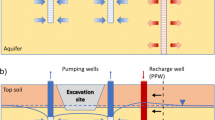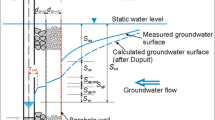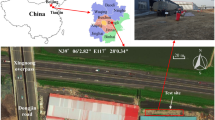Abstract
A wide variety of well drilling techniques and well completion methods is used in the installation of dewatering and artificial recharge wells for the purpose of construction dewatering. The selection of the optimal well type is always a trade-off between the overall costs of well completion and development, the optimal well hydraulics of the well itself, the hydraulic impact of the well on its surroundings, and the required operational life span of the well. The present study provides an analytical framework that can be used by dewatering and drilling companies to quantify the contribution to head loss of typical dewatering and artificial-recharge well configurations. The analysis shows that the placement of partially penetrating wells in high-permeability layers could promote the use of quick and cheap installation of naturally developed wells using jetting or straight-flush rotary drilling. In high-permeability layers, such wells can be favorable over wells completed with filter pack, which require extensive well development to remove the fines from the filter cake layer. The amount of total head loss during discharge/recharge at a volumetric rate of 20 m3/h per meter of filter length, into or from a gravely aquifer layer, is reduced by factors of 3–4 while using naturally developed well types instead of well types completed with a filter pack that contains a filter cake layer due to borehole smearing.
Résumé
Une grande variété de techniques de forage de puits et de méthodes de complétion d’ouvrages est utilisée dans l’installation de puits de dénoyage et de recharge artificielle à des fins de mise hors d’eau de construction. La sélection du type de puits optimal est toujours un compromis entre les coûts globaux de réalisation et de développement du puits, les caractéristiques hydrauliques optimales du puits lui-même, l’impact hydraulique du puits sur son environnement, et la durée de vie opérationnelle requise du puits. La présente étude fournit un cadre analytique qui peut être utilisé par les entreprises de dénoyage et de forage pour quantifier la contribution à la perte de charge des configurations typiques de puits de dénoyage et de recharge artificielle. L’analyse montre que la mise en place de puits partiellement pénétrants dans des couches à haute perméabilité pourrait favoriser l’utilisation d’une installation rapide et bon marché de puits développés naturellement à l’aide de forage au rotary à jets ou chasse directe. Dans les couches à haute perméabilité, de tels puits peuvent être favorables par rapport aux puits complétés par un ensemble de filtres, qui nécessitent un développement de puits approfondi pour éliminer les fines de la couche de la galette filtration colmatée sur les parois de l’ouvrage. La quantité de perte de charge totale pendant la décharge/recharge à un taux volumétrique de 20 m3/h par mètre de longueur de filtre, dans ou à partir d’une couche aquifère graveleuse, est réduite par des facteurs de 3–4 tout en utilisant des types de puits développés naturellement au lieu de puits types complets avec un massif filtrant qui contient une couche de galette filtrante en raison des projections de boue lors de la foration.
Resumen
En la instalación de pozos de drenaje y de recarga artificial para la construcción de sistemas de drenaje se utiliza una amplia variedad de técnicas de perforación y de métodos de terminación de pozos. La selección del tipo de pozo óptimo es siempre un compromiso entre los costos generales de terminación y desarrollo del pozo, la hidráulica óptima del pozo en sí, el impacto hidráulico del pozo en su entorno y la vida útil requerida del pozo. El presente estudio ofrece un marco analítico que pueden utilizar las empresas dedicadas a la perforación y el drenaje para cuantificar la contribución a la pérdida de carga de las configuraciones típicas de los pozos de drenaje y de recarga artificial. El análisis muestra que la colocación de pozos parcialmente penetrantes en capas de alta permeabilidad podría promover el uso de la instalación rápida y económica de pozos desarrollados naturalmente mediante la perforación por chorro o rotación directa. En las capas de alta permeabilidad, tales pozos pueden ser favorables sobre los pozos completados con prefiltros, que requieren un extenso desarrollo del pozo para eliminar los finos. La cantidad de pérdida total de carga durante la descarga/recarga a una tasa volumétrica de 20 m3/h por metro de longitud de filtro, en o desde una capa de acuífero gravitacional, se reduce en factores de 3–4 al utilizar tipos de pozos desarrollados naturalmente en lugar de los pozos terminados con un pack de filtros que contiene una capa en el filtro debido al arrastre de la perforación.
摘要
为了进行工程疏干, 在疏干和人工补给井的安装中使用了各种钻井技术和完井方法。最佳井型的选择始终需要权衡完井和开采的总成本、井本身的最佳井水力学、井对周围环境的水力影响以及井所需的使用寿命之间的关系。本研究提供了一个可供疏干和钻井公司用来量化典型疏干和人工补给井设计对水头损失贡献的分析框架。分析表明, 将非完整井放置在高渗透率层中, 有便于使用快速和廉价的自然开发井(采用旋喷或垂直冲洗旋钻)进行安装。在高渗透率层中, 采用充填过滤器的完井方式较好, 这需要钻探大量的井才能从滤饼层中除去细颗粒物。使用自然开发的油井类型而不是由于钻孔拖尾而包含滤饼层的充填过滤器的完井类型时, 当每米过滤器的长度的排泄或补给率在20 m3/h时, 总水头损失减少了3到4倍。
Resumo
Uma ampla variedade de técnicas de perfuração e métodos de preenchimento anelar é utilizada na instalação de poços de bombeamento e de recarga artificial para fins de rebaixamento de nível freático para obras de construção civil. A seleção do tipo de poço ideal frequentemente pondera custos de instalação e desenvolvimento do poço, as condições hidráulicas ideais intrínsecas ao poço, o impacto hidráulico do poço no seu entorno, e a vida útil poço. O presente estudo provê um arcabouço analítico que pode ser utilizado por empresas de rebaixamento de nível freático e de perfuração de poços para quantificar a contribuição da perda de carga hidráulica em configurações típicas de poços de rebaixamento de nível freático e recarga artificial. A análise mostra que a alocação de poços parcialmente penetrantes em camadas altamente permeáveis pode promover a utilização de instalação rápida e barata de poços de desenvolvimento natural utilizando jateamento ou sondagem rotativa com circulação direta. Em zonas de alta permeabilidade, tais poços podem ser mais favoráveis do que poços preenchidos com pré-filtro, o qual exige desenvolvimento extensivo para remover materiais finos do envoltório do poço e retido no pré-filtro. A quantidade total de perda de carga hidráulica durante a descarga/recarga volumétrica de 20 m3/h por metro de comprimento do filtro, adentro ou a partir de uma cama aquífera de cascalho, é reduzida entre 3–4 vezes quando utilizado poços de desenvolvimento natural ao invés de poços preenchidos com pré-filtro.








Similar content being viewed by others
References
Barker JA, Herbert R (1992) A simple theory for estimating well losses: with application to test wells in Bangladesh. Appl Hydrogeol 0:20–31
Barrash W, Clemo T, Fox JJ, Johnson TC (2006) Field, laboratory, and modeling investigations of the skin effect at wells with slotted casing, Boise Hydrogeophysical Research Site. J Hydrol 326(1–2):181–198
Basak P (1978) Analytical solutions for two-regime well flow problems. J Hydrol 38(1–2):147–159
Bear J (ed) (1988) Dynamics of fluids in porous media. Dover, New York
Bear J (ed) (2007) Hydraulics of groundwater. Dover, New York
Boulton NS (1947) Discussion of drawdown test to determine effective radius of artesian well by C. E. Jacob. Trans Am Soc Civil Eng 112(1):1065–1068
Bouwer H (2002) Artificial recharge of groundwater: hydrogeology and engineering. Hydrogeol J 10(1):121–142
Buscheck TA, Doughty C, Tsang CF (1983) Prediction and analysis of a field experiment on a multilayered aquifer thermal energy storage system with strong buoyancy flow. Water Resour Res 19(5):307–1315
Cashman PM, Preene M (2013) Groundwater lowering in construction: a practical guide to dewatering, 2nd edn. Taylor and Francis, Boca Raton, FL
De Zwart AH (2007) Investigation of clogging processes in unconsolidated aquifers near water supply wells. PhD Thesis, Technische Universiteit, Delft, The Netherlands
Driscoll FG (ed) (1986) Ground water and wells, 2nd edn. Johnson Filtration Systems, St. Paul, MN
Engelund F (1953) On the laminar and turbulent flow of groundwater through homogeneous sands. Transactions of the Danish Academy of Technical Sciences, Copenhagen, A.T.S. 3, Bulletin 4, Hydraulic Laboratories, Technical University of Denmark, Kongens Lyngby, Denmark
Ergun S (1952) Fluid flow through packed columns. Chem Eng Prog 48(2):89–94
Forchheimer PH (1901) Wasserbewegung durch Boden [Movement of water through soil]. Zeitschr Vereines Deutscher Ing 50(1736–1741):1781–1788
Houben GJ (2015a) Review: Hydraulics of water wells—flow laws and influence of geometry. Hydrogeol J 23(8):1633–1657
Houben GJ (2015b) Review: Hydraulics of water wells—head losses of individual components. Hydrogeol J 23(8):1659–1675
Houben GJ, Hauschild S (2011) Numerical modeling of the near-field hydraulics of water wells. Ground Water 49(4):570–575
Houben GJ, Halisch M, Kaufhold S, Weidner C, Sander J, Reich M (2016) Analysis of wellbore skin samples: typology, composition, and hydraulic properties. Ground Water 54(5):634–645
Houben GJ, Wachenhausen J, Guevara Morel CR (2018) Effects of ageing on the hydraulics of water wells and the influence of non-Darcy flow. Hydrogeol J 26(4):1285–1294
Kasenow M (2010) Applied ground-water hydrology and well hydraulics, 3rd edn. Water Resources Publ., Highlands Ranch, CO
de la Loma González B (2013) Clogging of deep well infiltration recharge systems in the Netherlands. In: Martin R (ed) Clogging issues associated with managed aquifer recharge methods. IAH Commission on Managing Aquifer Recharge, Richmond North, VIC, Australia, pp 163–173
Martin R (ed) (2013) Clogging issues associated with managed aquifer recharge methods. IAH Commission on Managing Aquifer Recharge, Richmond North, VIC, Australia
Moutsopoulos KN, Papaspyros INE, Tsihrintzis VA (2009) Experimental investigation of inertial flow processes in porous media. J Hydrol 374(3–4):242–254
Olsthoorn TN (1982) Verstopping van persputten [The clogging of recharge wells]. Keuringsdienst voor Waterleidingartikelen KIWA N.V, Rijswijk, The Netherlands
Powers P, Corwin A, Schmall P, Kaeck W (2007) Construction dewatering and groundwater control, 3rd edn. Wiley, Hoboken, NJ
Pyne RDG (2005) Aquifer storage recovery: a guide to groundwater recharge through wells, 2nd edn. ASR Systems, Gainesville, FL
Roscoe Moss Company (1990) Handbook of ground water development. Wiley, New York
Ruud NC, Kabala ZJ (1997) Response of a partially penetrating well in a heterogeneous aquifer: integrated well-face flux vs. uniform well face flux boundary conditions. J Hydrol 194:76–94
Timmer H, Verdel J-D, Jongmans AG (2003) Well clogging by particles in Dutch well fields. J Am Water Works Ass 95(8):112–118
Tügel F, Houben GJ, Graf T (2016) How appropriate is the Thiem equation for describing groundwater flow to actual wells? Hydrogeol J 24(8):2093–2101. https://doi.org/10.1007/s10040-016-1457-0
Van Beek CGEM, Breedveld RJM, Juhász-Holterman M, Oosterhof A, Stuyfzand PJ (2009a) Cause and prevention of well bore clogging by particles. Hydrogeol J 17(8):1877–1886
Van Beek CGEM, Breedveld RJM, Stuyfzand PJ (2009b) Preventing two types of well clogging. J Am Water Works Assoc 101(4):125–134
Van Lopik JH (2020) Design of recharge and abstraction well systems in heterogeneous aquifers: modeling and experimental studies. In: PhD Thesis, Utrecht University, Utrecht, The Netherlands
Van Lopik JH, Snoeijers R, van Dooren TCGW, Raoof A, Schotting RJ (2017) The effect of grain size distribution on nonlinear flow behavior in sandy porous media. Transp Porous Med 120(1):37–66
Van Lopik JH, Hartog N, Schotting RJ (2020a) Taking advantage of aquifer heterogeneity in designing construction dewatering systems with partially penetrating recharge wells. Hydrogeol J. https://doi.org/10.1007/s10040-020-02226-7
Van Lopik JH, Zazai L, Hartog N, Schotting RJ (2020b) Nonlinear flow behavior in packed beds of natural and variably graded granular material. Transp Porous Med 131:957–983
Zhu Q, Wen Z (2019) Combined role of leaky and non-Darcian effects on the flow to a pumping well with a non-uniform flux well-face boundary. J Hydrol 580:123532. https://doi.org/10.1016/j.jhydrol.2019.02.058
Zuurbier KG, Zaadnoordijk WJ, Stuyfzand PJ (2014) How multiple partially penetrating wells improve the freshwater recovery of coastal aquifer storage and recovery (ASR) systems: a field and modeling study. J Hydrol 509:430–441
Acknowledgements
The authors wish to thank Georg J. Houben from the Bundesanstalt für Geowissenschaften und Rohstoffe for his critical comments on prior drafts of this paper and Dr. A. Mouraz Miranda and an anonymous reviewer for their constructive feedback. Moreover, the authors wish to thank dewatering companies Theo van Velzen, Henk van Tongeren and P.J. de Vet & Zonen for providing well specifications of typical dewatering deep wells and artificial recharge wells.
Funding
This work was supported by the foundations STW (Foundation for Technical Sciences) and O2DIT (Foundation for Research and Development of Sustainable Infiltration Techniques).
Author information
Authors and Affiliations
Corresponding author
Appendix
Appendix
Solution for the Darcy-Forchheimer equation for converging flow in filter packs towards screen slots
Inside a filter pack, groundwater flow is affected by the presence of well screens. During abstraction, groundwater has to converge to the screen slots, which causes an additional head called ∆hcv. Boulton (1947) derived an equation for ∆hcv based on the ratio (δs) of slot aperture (l) and circumference of the well:
where ns is the number of slots inside the circumference of a well and R is the radius of the well. The equation by Boulton (1947) is given by (Houben 2015b):
where Kfp is the hydraulic conductivity of the gravel pack and Ls is the length of the screen. Unfortunately, the derivation of Boulton’s equation is not given in that article and therefore the assumptions behind the equation are unknown; thus, a derivation of the equation for ∆hcv is given in the following.
The starting point of the derivation is the Darcy-Forchheimer equation, which is given by:
where r is a radial coordinate. By separating variables, one can obtain:
The Darcy-Forchheimer equation is independent of slot aperture, therefore a geometric consideration is conducted before solving the Darcy-Forchheimer equation.
In order to obtain Boulton’s equation, the distance between the well circumference and the opening (distance D) has to be considered constant (see Fig. 9). This assumption implies that flow remains radial inside the gravel pack until the groundwater is very close to the well. As a consequence, stagnant zones of groundwater arise between the screen slots (see Fig. 9) which forces the remaining groundwater towards the screen openings. Distance D is defined for any circle having a radius r as such that D is constant (based on trigonometry; see Fig. 9):
Differentiating Eq. (22), yields:
Using Eqs. (22 and 23), the Darcy-Forchheimer equation becomes:
In Eq. (24), the radial coordinates are projected on δ coordinates, which represents flow perpendicular to the radius. The boundary conditions for Eq. (24) are:
Defining integration of Eq. (24) yields:
Finally, one can obtain:
where the Forchheimer coefficient \( b=\frac{\beta }{K_{\mathrm{fp}}^2} \)
Schematic overview of flow convergence in the filter pack (assumption by Boulton 1947)
Rights and permissions
About this article
Cite this article
van Lopik, J.H., Sweijen, T., Hartog, N. et al. Contribution to head loss by partial penetration and well completion: implications for dewatering and artificial recharge wells. Hydrogeol J 29, 875–893 (2021). https://doi.org/10.1007/s10040-020-02228-5
Received:
Accepted:
Published:
Issue Date:
DOI: https://doi.org/10.1007/s10040-020-02228-5





